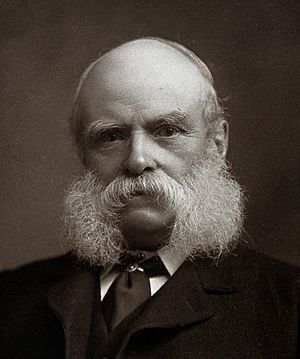Sir Andrew Noble, 1st Baronet facts for kids
Quick facts for kids
Andrew Noble
|
|
|---|---|

Sir Andrew Noble c. 1907
|
|
| Born | 13 September 1831 Greenock, Scotland
|
| Died | 22 October 1915 (aged 84) Argyll, Scotland
|
| Nationality | Scottish |
| Known for | Ballistics |
| Spouse(s) | Margery Durham Campbell (m. 1854) |
| Children | 2 daughters, 4 sons |
| Awards | Royal Medal (1880) Albert Medal (1909) |
| Scientific career | |
| Fields | Physics |
Sir Andrew Noble, 1st Baronet (born September 13, 1831 – died October 22, 1915) was a Scottish scientist. He was a physicist who became famous for his work on ballistics (the study of how projectiles like bullets or cannonballs move) and gunnery (the use of guns). He helped make cannons and guns much more powerful and accurate.
Contents
Early Life and Military Career
Andrew Noble was born in Greenock, Scotland. He went to school at Edinburgh Academy and then studied at the Royal Military Academy, Woolwich. In 1849, he joined the Royal Artillery as an officer.
He was promoted to captain in 1855. Later, he became the secretary of the Royal Artillery Institution. He also worked on a special government committee. This committee was looking for ways to replace old, smooth-bore cannons with newer, more accurate rifled artillery. Noble did a lot of research to help with this important change.
Amazing Work in Artillery
In 1860, Andrew Noble joined a company called Armstrong's, which made weapons. He started as a joint manager and soon became a partner. Here, he continued his research on artillery. He invented new ways to measure the pressure inside a gun's breech (the back part of the barrel) when it fired.
In 1862, he created a special device called the Electro-Mechanical Chronoscope. This invention could measure very short time differences. He used it to time how fast projectiles moved inside a gun barrel. This helped him figure out how well different types of gunpowder worked.
Improving Gunpowder and Guns
Noble worked with another scientist, Sir Frederick Abel, to make black powder better. They made it burn more slowly, which created more gas and a steadier pressure. This improvement allowed guns to shoot projectiles much faster. The speed increased from about 1600 feet per second to 2100 feet per second! This also made the guns about 75% more powerful.
Noble's work also helped Sir Frederick Abel create a new type of smokeless powder called cordite in 1889. These new powders meant that guns and their mounts had to be redesigned. Armstrong's company, where Noble worked, made these new designs. This gave them a big advantage over other companies.
Growing a Business Empire
Thanks to these advancements, Armstrong's company grew a lot. They started building ships, locomotives (train engines), tanks, and even aircraft. By 1914, it had become one of the biggest weapon-making companies in the world.
Around 1890, Sir William Armstrong started to retire from leading the company. Andrew Noble's main role then changed from being a scientist to a businessman. In 1900, he officially became the chairman of the company. He was in charge during much of this huge growth. Noble even said that all the Japanese guns that sank the Russian fleet in the important battle of Tsushima in 1905 were made at Armstrong's Elswick factory.
Recognized for His Achievements
In 1870, when he was 38, Andrew Noble was recognized for his scientific work. He was elected a Fellow of the Royal Society, which is a very respected group of scientists. He received the Society's Gold Medal in 1880.
He was honored with several titles:
- He became a Companion of the Order of the Bath in 1881.
- He was knighted in 1893, which meant he could be called "Sir."
- In 1902, he was given the title of Baronet, which is a hereditary title.
Family Life
In 1854, while he was serving in Quebec, Canada, Andrew Noble married Margery Durham Campbell. They had six children: four sons and two daughters. Margery lived to be 101 years old!
Some of Noble's sons and grandsons also became important figures. His sons, George and Saxton, became baronets after him. His third son, John Noble, also worked with Armstrong's and later became a baronet himself. John's youngest son, Michael Noble, became a well-known politician.
Noble's youngest daughter, Ethel, married Alfred Cochrane, who was a cricketer and a poet. He also worked as the Company Secretary at Armstrong's.
Building Beautiful Homes
Andrew Noble and his sons used their wealth to build many impressive houses. They hired some of the best architects of their time.
- In 1871, Noble bought Jesmond Dene House. He hired famous architects to make it much bigger, adding new rooms and a grand hall. He also built a special indoor tennis court there. Today, Jesmond Dene House is a hotel and restaurant.
- In 1905, Noble bought the Ardkinglas estate in Scotland. He asked Sir Robert Lorimer to build a large new house there, which is considered one of Lorimer's best works.
- His sons also commissioned grand homes, showing their family's interest in architecture and design.
Awards and Honors
Sir Andrew Noble received many awards and honors for his contributions to science and industry:
- Grand Cross of the Imperial Order of the Rose
- Commander of the Order of the Crown of Italy
- Commander of the Portuguese Order of Christ
- Royal Medallist of the Royal Society (1880)
- Companion of the Order of the Bath (1881)
- Knight Commander of the Order of the Bath (1893)
- Knight of the Order of Charles III
- Baronet in the Baronetage of the United Kingdom (1902)
See also
- Internal ballistics
- Noble baronets

